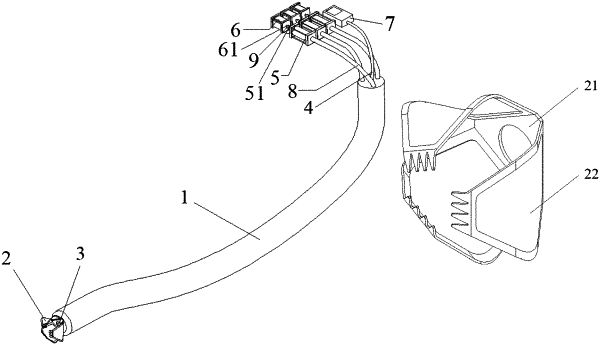| CPC A61B 34/30 (2016.02) [A61B 1/273 (2013.01); A61B 90/30 (2016.02); A61B 90/361 (2016.02); A61B 2034/301 (2016.02); A61B 2562/0285 (2013.01); A61B 2562/162 (2013.01)] | 9 Claims |

|
1. A diagnosis and treatment integrated soft medical robot for gastrointestinal endoscopy, comprising: a robot body (1), a camera (3), illumination devices, a flexible dielectric elastomer actuator (2), air cylinders (5), linear motors (6), a controller (7) and external hoses (8), wherein the robot body (1) is a multichannel hose, and comprises a central channel (12) and circumferential channels; the central channel (12) is configured to accommodate conducting wires and signal wires (4); the circumferential channels comprise at least three microfluid channels; a front end of each of the microfluid channels is a sealed end; a rear end of each of the microfluid channels is an open end; and the open end of each of the microfluid channels is communicated with a flow channel port of an air cylinder (5);
the camera (3) is disposed at a front end of the central channel (12) of the robot body, and a plurality of illumination devices are distributed around the camera (3);
the flexible dielectric elastomer actuator (2) is disposed at a front end of the robot body (1) and is fixedly connected to the front end of the robot body (1); the air cylinders (5), the linear motors (6) and the controller (7) are all disposed at a rear end of the robot body (1); each of the microfluid channels is correspondingly disposed with one air cylinder; each of the air cylinders corresponds to one linear motor; the microfluid channels and the corresponding air cylinders are connected through the external hoses (8); a piston rod (51) of the air cylinder (5) is connected with a shaft (61) of the corresponding linear motor through a coupling (9), and conducting wires and signal wires (4) of the camera (3) and conducting wires and signal wires (4) of the flexible dielectric elastomer actuator (2) are all connected with the controller (7); the linear motors (6) drive the piston rods (51) of the corresponding cylinders (5) to control a fluid pressure in the three microfluidic channels, respectively, so that the robot body (1) can turn flexibly under a fluid drive; and the camera (3) performs real-time image acquisition, and the controller (7) controls the flexible dielectric elastomer actuator (2) to capture a target;
and wherein the flexible dielectric elastomer actuator (2) comprises a flexible dielectric elastomer actuator framework (21) and three dielectric elastomer driving units (22); the flexible dielectric elastomer actuator framework (21) comprises a framework main body (211) and three capture arms (212); the three capture arms (212) are uniformly disposed on the periphery of the framework main body (211), and one dielectric elastomer driving unit (22) is pasted to an inner side of each of the capture arms (212); the three capture arms (212) are folded to be in a gathered state; the dielectric elastomer driving units (22) comprise a first encapsulation protection layer (224), a first sensing layer (223), a second sensing layer (225), a second encapsulation protection layer (226), a first flexible electrode layer (222), a dielectric elastomer layer (221), a second flexible electrode layer (227) and a third encapsulation protection layer (228) sequentially disposed from inside to outside; and an area of the dielectric elastomer layer (221) can be expanded or contracted by adjusting a driving voltage, so that the flexible dielectric elastomer actuator (2) can be driven to complete an opening or closing action, so as to capture the target.
|